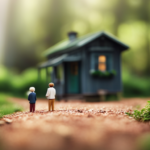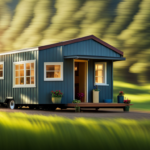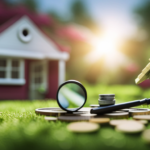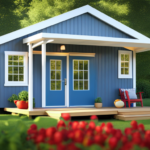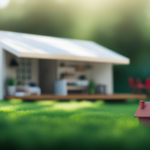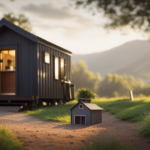Beginners Guides
How Much Does A Tiny House Cost On Average

Envision a residence that perfectly aligns with your desires and necessities, all while keeping your finances intact. Introducing the realm of tiny homes, a place where cost-effectiveness converges with practicality. These compact abodes have won over numerous individuals, presenting an option for a more straightforward and eco-friendly lifestyle.
But just how much does a tiny house cost on average? In this article, I will delve into the nitty-gritty details, providing you with all the data-driven information you need to make an informed decision. From the various types of tiny houses available to the factors that influence their price, we will explore both the average cost of building a tiny house from scratch and the average cost of purchasing a pre-built one.
We will also discuss financing options, compare the cost of tiny houses to traditional homes, and highlight hidden costs to consider. So, if you’re ready to embark on the journey of downsizing and embracing a minimalist lifestyle, let’s dive in and discover the true cost of living tiny.
Key Takeaways
- The average cost of building a tiny house ranges from $20,000 to $100,000.
- Factors such as size, location, materials, and level of customization influence the cost of a tiny house.
- Financing options for tiny houses include personal loans, specialized tiny house financing, and crowdfunding.
- Tiny houses offer affordable and sustainable living options with lower utility costs and potential maintenance and repair savings.
Types of Tiny Houses Available
There’s a wide variety of tiny houses available, each with their own unique features and styles! When it comes to types of tiny houses, there are several options to choose from.
One common type is the traditional tiny house on wheels, which is built on a trailer and can be easily moved. These houses often have a lofted sleeping area to maximize space.
Another type is the container home, which is made by converting shipping containers into livable spaces. These homes have a modern and industrial aesthetic.
Additionally, there are tiny houses that are built using alternative construction methods such as straw bale or cob. These methods offer sustainable and eco-friendly options for those interested in reducing their carbon footprint.
The different types of tiny houses are not only differentiated by their construction methods but also by their sizes and layouts. Some tiny houses are designed to be completely off-grid, utilizing solar panels and composting toilets. Others may have more traditional amenities like plumbing and electricity.
The cost of a tiny house can vary greatly depending on its type and the materials used in its construction. Factors such as the size, location, and level of customization can also influence the cost.
Now, let’s explore the factors that influence the cost of a tiny house in more detail.
Factors Influencing the Cost
One key factor that heavily impacts the price tag of a petite abode is the array of features and customizations chosen by the aspiring homeowner. These factors affecting pricing include:
-
Size: The larger the tiny house, the more materials and labor will be required, resulting in higher costs.
-
Location: Building a tiny house in a high-cost area, such as a major city or popular tourist destination, can significantly increase the overall price.
-
Materials: The choice of materials, such as high-end finishes or eco-friendly options, can impact the cost.
-
Off-grid capabilities: Incorporating renewable energy systems, water filtration systems, or composting toilets can add to the price but may reduce long-term expenses.
Considering these budgeting considerations, it’s important for individuals to carefully consider their priorities when designing their tiny house. While some features may increase the cost, they could also enhance the overall living experience. Furthermore, it’s crucial to establish a budget and stick to it to avoid overspending.
By understanding these factors and making informed choices, aspiring homeowners can create a tiny house that meets their needs while staying within their budget.
Moving on to the next section, let’s explore the average cost of building a tiny house.
Average Cost of Building a Tiny House
To get a clear idea of the expenses involved in constructing your dream compact dwelling, imagine yourself envisioning the final product and the financial commitment it entails. When it comes to building a tiny house, the cost can vary depending on factors such as size, materials used, and location. However, on average, the cost of building a tiny house ranges from $20,000 to $100,000. To give you a better understanding of the potential costs, here is a breakdown of the average prices for different types of tiny house designs:
| Tiny House Design | Average Cost |
|---|---|
| Shell Only | $20,000 – $30,000 |
| Basic | $30,000 – $50,000 |
| Mid-range | $50,000 – $75,000 |
| High-end | $75,000 – $100,000 |
When it comes to saving costs in tiny house construction, there are several measures you can take. These include using salvaged or recycled materials, sourcing affordable appliances and fixtures, and opting for a simpler design. By making smart choices, you can reduce the overall expenses without compromising on the quality and functionality of your tiny house. Transitioning into the subsequent section about the average cost of buying a pre-built tiny house, it is important to consider the benefits and drawbacks of both building and buying options.
Average Cost of Buying a Pre-Built Tiny House
When it comes to purchasing a pre-built tiny house, you’ll find yourself in awe of the artistic craftsmanship and the price tag that accompanies it. The cost of a pre-built tiny house can vary depending on several factors. Here are two sub-lists that can help you understand the types of pre-built tiny houses and the factors affecting their prices:
Types of Pre-Built Tiny Houses:
- Traditional Style: These tiny houses are designed to resemble conventional homes, with a pitched roof and standard amenities. They usually have a higher price tag due to their larger size and more intricate design.
- Modern Style: These tiny houses focus on minimalist design and often incorporate innovative features. They tend to be more affordable compared to traditional style houses.
Factors Affecting Pre-Built Tiny House Prices:
- Size: The larger the tiny house, the higher the cost.
- Location: Prices can vary based on the region and local building regulations.
- Materials: The type and quality of materials used can impact the price.
- Customization: Additional features and customization options can increase the cost.
Understanding these factors can help you make an informed decision when purchasing a pre-built tiny house.
In the next section, we will explore financing options for tiny houses without compromising your dream of owning one.
Financing Options for Tiny Houses
Financing options for tiny houses allow you to fulfill your dream of owning a beautiful and affordable home. When it comes to acquiring a tiny house, there are various loan options available. Many traditional lenders offer personal loans specifically designed for tiny house purchases. These loans typically have lower interest rates and longer repayment terms compared to other types of loans.
Additionally, some lenders specialize in tiny house financing, offering tailored loan options to meet your specific needs. Crowdfunding is another option to consider for financing your tiny house. This involves creating a campaign online and asking individuals or groups to contribute towards your home. Crowdfunding platforms have gained popularity in recent years and can be a great way to gather funds for your tiny house project.
It’s important to carefully consider your financing options and choose the one that best suits your financial situation. Whether you opt for a traditional loan or choose to crowdfund, be sure to thoroughly research and compare interest rates, terms, and repayment options.
Financing options for tiny houses provide a feasible path to making your dream home a reality. Once you secure the financing, you can move on to the next step, which is understanding the ongoing expenses of living in a tiny house.
Ongoing Expenses of Living in a Tiny House
When considering the ongoing expenses of living in a tiny house, there are several key points to consider.
First, utilities costs can be significantly lower compared to a traditional home, due to the smaller size and efficient use of resources.
Second, maintenance and repair costs may also be reduced, as there’s less square footage to maintain and fewer systems to maintain or replace.
Lastly, parking and land costs can vary depending on location, but in general, they tend to be lower since tiny houses require less land.
Utilities
To keep your utilities affordable, you’ll want to consider energy-efficient appliances and solar panels for your tiny house. Here are three energy-saving tips to help you minimize your utility bills and embrace off-grid living:
-
Install LED lighting: LED bulbs use significantly less energy and last longer than traditional incandescent bulbs. By replacing all your lights with LED bulbs, you can reduce your energy consumption and save money on electricity.
-
Optimize insulation: Proper insulation is crucial for maintaining a comfortable temperature inside your tiny house. Insulating your walls, floors, and roofs effectively will help prevent heat loss during the winter and keep your house cool in the summer, reducing your reliance on heating and cooling systems.
-
Harvest rainwater: Collecting rainwater in barrels or tanks can provide you with a sustainable water source for various household needs, such as flushing toilets or watering plants. This can help reduce your water bills and make your tiny house more self-sufficient.
By implementing these energy-saving strategies, you can not only save money but also reduce your environmental impact. Transitioning into the subsequent section about maintenance and repairs, it’s important to address the potential costs associated with keeping your tiny house in good condition.
Maintenance and Repairs
Taking care of your tiny house requires regular maintenance and repairs to ensure its longevity and functionality. It’s important to stay on top of maintenance tasks to prevent small issues from turning into costly problems. Here are some maintenance tips to keep your tiny house in good shape.
-
First, regularly inspect the roof and siding for any signs of damage or wear. Repairing small leaks or cracks early can save you from major repairs down the line.
-
Additionally, keep an eye on the plumbing and electrical systems, checking for leaks, loose connections, or faulty wiring.
When it comes to repairs, opting for cost-effective solutions can help you save money. Consider DIY repairs or hiring local professionals who specialize in tiny house maintenance. By taking these preventative measures and addressing repairs promptly, you can ensure that your tiny house remains in optimal condition.
Transitioning into the subsequent section about ‘parking and land costs’, it’s important to consider the overall expenses associated with owning a tiny house.
Parking and Land Costs
Parking and land costs can be as unpredictable as a wild rollercoaster ride, adding excitement and anticipation to the overall ownership experience. When it comes to parking a tiny house, it is important to consider local parking regulations and zoning restrictions. These regulations vary from place to place and can greatly impact where you can park your tiny house. Some areas may have strict regulations that limit the places where you can park, while others may be more lenient. Additionally, land costs can vary greatly depending on the location. Urban areas and desirable neighborhoods tend to have higher land costs, while rural areas may offer more affordable options. It is essential to do thorough research and consider these factors when deciding where to park your tiny house. Transitioning into the next section about cost comparison, it is important to evaluate the overall expenses between a tiny house and a traditional home.
Cost Comparison: Tiny House vs. Traditional Home
When comparing the cost of a tiny house to a traditional home, there are three key points to consider: the initial investment, monthly expenses, and long-term financial considerations.
In terms of the initial investment, tiny houses are generally more affordable, with an average cost significantly lower than that of a traditional home.
However, monthly expenses can vary depending on factors such as utilities and maintenance, making it important to carefully consider ongoing costs.
Additionally, long-term financial considerations should be taken into account, as the resale value and potential appreciation of a tiny house may differ from that of a traditional home.
Initial Investment
To accurately determine the initial investment for a tiny house, you need to consider various factors such as location, materials, and customizations. Financing options play a significant role in the affordability of a tiny house. Some people may choose to pay for their tiny house upfront, while others may opt for loans or even crowdfunding.
Additionally, long-term savings should be taken into account when evaluating the initial investment. Tiny houses are known for their energy efficiency, which can lead to reduced utility bills. Moreover, the smaller size means lower maintenance costs and fewer expenses on furnishings.
Overall, the initial investment for a tiny house can vary greatly depending on individual choices and circumstances. Moving on to monthly expenses, it is important to plan for ongoing costs to ensure a sustainable tiny house lifestyle.
Monthly Expenses
Managing your monthly expenses for a tiny house is like tending to a beautiful garden – it requires careful attention and nurturing to ensure a sustainable and flourishing lifestyle. When it comes to monthly budgeting, it’s crucial to track your expenses and create a realistic budget that aligns with your income.
This will help you prioritize your spending and identify areas where cost-saving strategies can be implemented. Some effective ways to save money include minimizing energy usage by investing in energy-efficient appliances, adopting sustainable habits like composting and rainwater harvesting, and exploring alternative options for utilities such as solar power.
Additionally, being mindful of your grocery shopping, entertainment, and transportation expenses can contribute significantly to your monthly savings. By implementing these strategies, you can better manage your expenses and ensure a financially stable life in your tiny house.
Looking ahead, long-term financial considerations, such as maintenance and potential resale value, should also be factored into your overall financial plan.
Long-Term Financial Considerations
Looking ahead, it’s important to consider the long-term financial implications of owning a tiny house, including maintenance and potential resale value. When it comes to financing options, there are several routes to explore. Some people choose to save up and pay for the tiny house in cash, while others opt for loans or mortgages. It’s crucial to carefully analyze the interest rates and terms of any financing option to ensure it aligns with your financial goals.
Additionally, minimizing expenses is key to long-term financial stability. This can be achieved through energy-efficient appliances, solar panels, and water-saving fixtures. Regular maintenance and repairs are also necessary to preserve the value of the tiny house. By taking these factors into account, you can make informed decisions about your long-term financial strategy for your tiny house.
Looking ahead, let’s explore some tips for saving money on a tiny house.
Tips for Saving Money on a Tiny House
When it comes to saving money on a tiny house, there are several key points to consider.
First, taking on a do-it-yourself project can significantly reduce costs as you can utilize your own skills and labor.
Second, buying used or repurposed materials can be a cost-effective option, as they’re often sold at a fraction of the price of new materials.
Lastly, focusing on energy efficiency and sustainability can not only save you money in the long run but also contribute to a more environmentally friendly lifestyle.
Do-It-Yourself Projects
If you’re up for it, tackling a DIY project for your tiny house can be a budget-friendly option. Many people choose to build their own tiny houses instead of hiring professionals, as it can save a significant amount of money. Additionally, DIY projects allow for more creative freedom and unique design ideas. You have the opportunity to customize your tiny house to fit your specific needs and preferences.
However, it’s important to consider your skill level and the time commitment required for a DIY project. Building a tiny house from scratch requires knowledge in construction and various trades. If you’re not confident in your abilities, it may be worth hiring professionals to ensure a safe and well-built structure.
Next, I will discuss the benefits of buying used or repurposed materials for your tiny house, which can further reduce costs.
Buying Used or Repurposed Materials
Using used or repurposed materials for your tiny house can significantly cut down on expenses while still allowing for customization and unique design. Upcycling materials not only helps the environment by reducing waste but also provides a cost-effective solution for building a tiny house. By repurposing items such as reclaimed wood, salvaged windows, and recycled fixtures, you can create a sustainable and eco-friendly living space.
Additionally, using these materials adds character and a sense of history to your tiny house. Incorporating eco-friendly building materials, such as bamboo flooring or recycled insulation, further enhances the sustainability of your project.
Transitioning into the next section about energy efficiency and sustainability, it’s important to consider how the use of repurposed materials can contribute to a more environmentally friendly and energy-efficient tiny house.
Energy Efficiency and Sustainability
To maximize energy efficiency and sustainability in your tiny house, consider incorporating eco-friendly materials and implementing energy-saving strategies. By using materials such as reclaimed wood, recycled insulation, and low VOC paints, you can reduce your environmental impact while also creating a healthier living space.
Additionally, installing energy-efficient appliances, such as LED lighting and energy-star rated HVAC systems, can significantly decrease your energy consumption and lower utility costs. Sustainable living practices, such as harvesting rainwater and utilizing solar panels for electricity, further enhance the energy efficiency benefits of a tiny house.
These practices not only save money in the long run but also contribute to a greener and more sustainable lifestyle. However, it’s important to consider the hidden costs associated with these eco-friendly features, such as maintenance and installation expenses, when budgeting for your tiny house project.
Hidden Costs to Consider
Hidden costs can sneak up on you like a mischievous leprechaun, adding an extra layer of expenses to your tiny house project. While the idea of a tiny house may seem cost-effective, it is important to consider the hidden costs and unexpected expenses that can arise throughout the process. To give you a clearer picture, let’s examine a table that outlines some common hidden costs to consider:
| Hidden Costs | Average Cost | Description |
|---|---|---|
| Building Permits | $500 – $5,000 | Required for construction and can vary depending on location |
| Land and Utilities | $10,000 – $50,000+ | Costs for purchasing or leasing land and connecting utilities |
| Customization and Upgrades | $5,000 – $20,000+ | Additional expenses for personalizing your tiny house |
| Maintenance and Repairs | $1,000 – $5,000+ | Regular upkeep and unforeseen repairs can add up over time |
| Insurance and Financing Fees | $1,000 – $5,000+ | Additional costs for insuring your tiny house and financing |
It is essential to factor in these hidden costs when budgeting for your tiny house. While the initial cost of building a tiny house may be lower than a traditional home, these additional expenses can quickly add up. However, despite these hidden costs, living in a tiny house can still be worth the investment. Transitioning into the next section, let’s explore whether the benefits of tiny house living outweigh the financial considerations.
Is Living in a Tiny House Worth the Cost?
When considering whether living in a tiny house is worth the investment, you may find that the benefits of this unique lifestyle far outweigh the financial considerations. While the cost of a tiny house may be significantly lower than that of a traditional home, it is essential to weigh the pros and cons before making a decision.
Here are four key factors to consider when evaluating the lifestyle impact of living in a tiny house:
-
Simplified Living: One of the significant advantages of a tiny house is the opportunity to declutter and simplify your life. With limited space, you’re forced to prioritize your belongings and live with only what you truly need. This minimalist approach can lead to a more organized and stress-free lifestyle.
-
Financial Freedom: Living in a tiny house can provide considerable cost savings, both in terms of construction and ongoing expenses. With a smaller mortgage or no mortgage at all, you can allocate more resources towards other financial goals, such as savings, travel, or pursuing your passions.
-
Environmental Impact: Tiny houses are inherently more sustainable and eco-friendly compared to larger homes. They require fewer materials to build, consume less energy for heating and cooling, and have a smaller carbon footprint overall. By choosing a tiny house, you can contribute to a greener future.
-
Sacrifices and Limitations: It’s important to acknowledge that living in a tiny house comes with sacrifices and limitations. Limited storage space, privacy concerns, and potential zoning restrictions are factors that may impact your daily life. It’s crucial to assess whether these trade-offs align with your personal preferences and lifestyle goals.
Living in a tiny house can offer numerous benefits, such as simplified living, financial freedom, and environmental consciousness. However, it’s essential to carefully evaluate the potential sacrifices and limitations before committing to this lifestyle.
Frequently Asked Questions
What are the dimensions of a typical tiny house?
Typical tiny house dimensions range from 100 to 400 square feet, with an emphasis on designing for space efficiency. Maximizing vertical space and incorporating multi-functional furniture and creative storage solutions are key to making the most of limited square footage.
Are there any regulations or zoning restrictions for parking or living in a tiny house?
While parking restrictions and zoning regulations vary by location, it’s important to research and comply with local laws before living in a tiny house. These regulations ensure safety, prevent overcrowding, and maintain the overall integrity of the community.
How long does it take to build a tiny house?
On average, it takes about 3-6 months to build a tiny house. The building timeline can vary depending on the complexity of the design, availability of materials, and the construction process.
Can a tiny house be customized or modified after it is built?
Customization options for tiny houses are endless. Post construction modifications are common and can include adding or removing walls, changing layouts, or upgrading appliances. The flexibility of tiny houses allows for personalized design and functionality.
Are there any maintenance or repair costs associated with owning a tiny house?
Yes, there are maintenance costs and repair expenses associated with owning a tiny house. Regular upkeep, such as cleaning, painting, and fixing minor issues, can add up over time. Additionally, major repairs, like replacing appliances or fixing structural damage, can be significant expenses.
Conclusion
In conclusion, after delving into the world of tiny houses, it’s clear that they offer a unique and affordable living option for those seeking a simpler lifestyle. The average cost of a tiny house, whether self-built or pre-built, can vary depending on factors such as size, materials, and location. However, with careful planning and consideration of hidden costs, the dream of living in a tiny house can become a reality.
So why not take a leap into this small but mighty world and unlock the freedom and financial benefits it has to offer?
Hi, I’m Emma. I’m the Editor in Chief of Tiny House 43, a blog all about tiny houses. While tree houses are often associated with childhood, they can be the perfect adult retreat. They offer a cozy space to relax and unwind, surrounded by nature. And since they’re typically built on stilts or raised platforms, they offer stunning views that traditional homes simply can’t match. If you’re looking for a unique and romantic getaway, a tree house tiny house might just be the perfect option.
Beginners Guides
How Did the City of Fresno to Tiny House
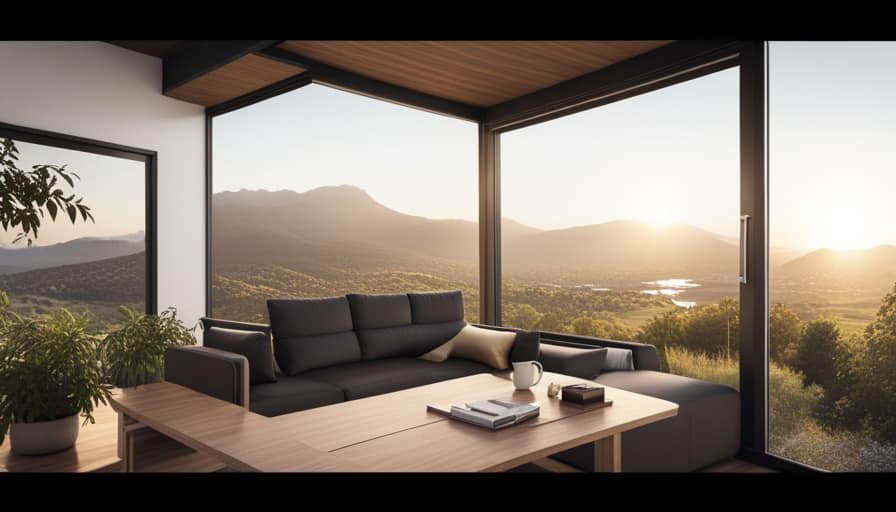
As someone living in Fresno, I have always believed in the saying ‘home is where the heart is.’ Thanks to the city’s forward-thinking housing policies, even the smallest of homes can now have a place to call their own.
In this article, we’ll explore how Fresno has embraced the tiny house movement, collaborating with advocates and implementing innovative zoning regulations. Join me as we delve into the challenges faced and the remarkable progress made towards building a thriving tiny house community in Fresno.
Key Takeaways
- Fresno has implemented housing policies and initiatives aimed at increasing access to affordable housing, including energy-efficient homes and tiny house construction.
- Collaboration with tiny house advocates is crucial for effective housing solutions, as they bring valuable insights and innovative ideas to the table.
- Zoning regulations and permitting processes in Fresno are designed to engage the community and ensure that their needs and preferences are considered.
- Fresno has created innovative tiny house communities that focus on sustainability and affordability, incorporating features such as solar panels and rainwater harvesting systems.
The Shift in Housing Policies
I’m excited to talk about the changes happening in housing policies.
One of the most pressing issues in our society today is housing affordability. Many individuals and families struggle to find affordable housing options, causing financial strain and instability.
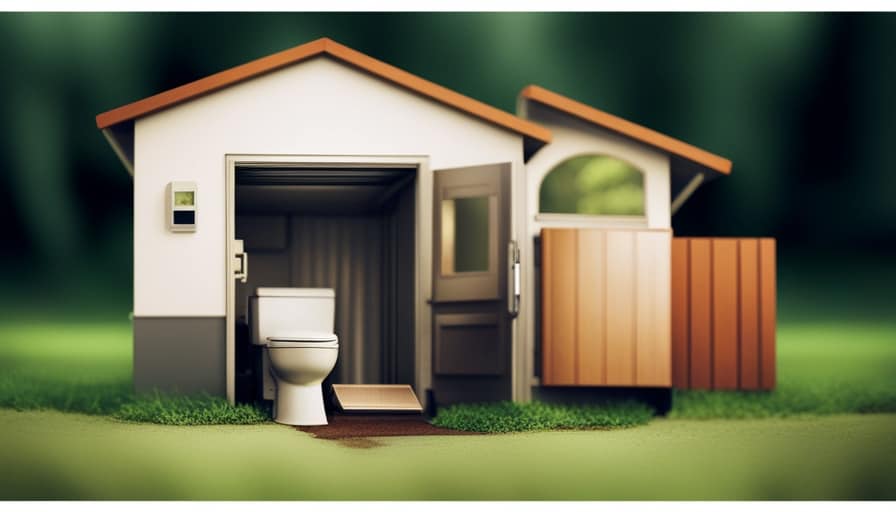
As a result, there’s been a shift in housing policies towards promoting sustainable living and increasing access to affordable housing. Governments and organizations are recognizing the importance of creating housing opportunities that are both environmentally friendly and economically viable.
This involves initiatives such as promoting energy-efficient homes, supporting the construction of tiny houses, and implementing rent control measures.
Collaborating With Tiny House Advocates
Collaborating with tiny house advocates has been crucial in implementing effective housing solutions in the city of Fresno. Through collaboration strategies and community engagement, we’ve been able to work hand in hand with advocates to address the unique challenges and opportunities that tiny houses present.
These collaborations have allowed us to tap into the knowledge and expertise of tiny house advocates, who bring valuable insights and innovative ideas to the table. We’ve engaged in open and transparent dialogues, fostering a sense of trust and understanding between all parties involved.
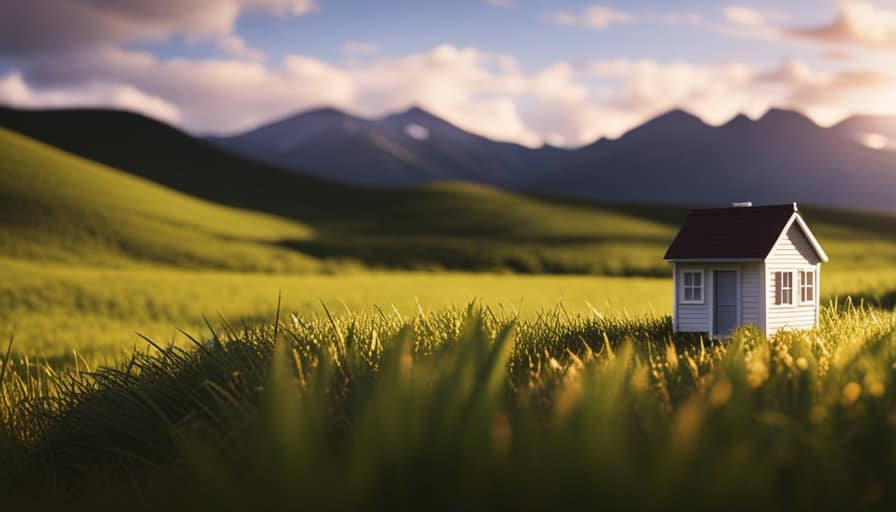
Zoning Regulations and Permitting Processes
Navigating the complexities of zoning regulations and permitting processes can be challenging, but it’s essential for ensuring the successful implementation of tiny house communities in the city of Fresno.
To streamline processes and make it easier for individuals and organizations to develop tiny house communities, the city of Fresno has taken steps to engage with the community and actively involve them in the decision-making process.
This includes hosting public meetings, soliciting feedback, and conducting thorough assessments of potential sites for tiny house communities. By involving the community in these processes, the city of Fresno can address any concerns or issues that may arise, while also ensuring that the needs and preferences of the community are taken into consideration.
This collaborative approach not only helps to build trust and support, but also allows for a more efficient and effective implementation of tiny house communities in the city.
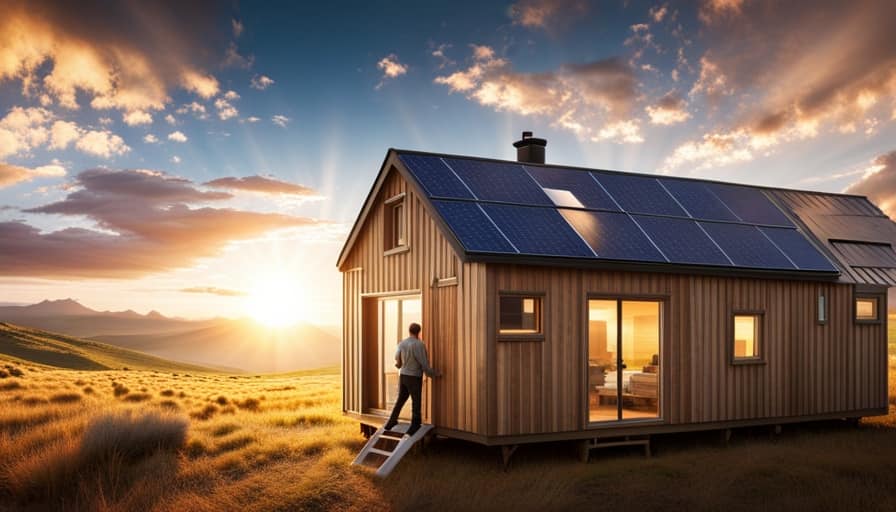
Innovative Tiny House Communities in Fresno
One innovative approach to creating tiny house communities in Fresno is through the use of sustainable materials and renewable energy sources. These communities are designed with a focus on sustainability, incorporating features such as solar panels, rainwater harvesting systems, and energy-efficient appliances. By utilizing these sustainable practices, residents can reduce their carbon footprint and live in homes that are environmentally friendly.
Additionally, these communities aim to provide affordable living options for individuals who may not be able to afford traditional housing. Through the use of smaller, more efficient spaces, the cost of construction and maintenance is reduced, making it more accessible for those on a limited budget.
These innovative tiny house communities in Fresno are paving the way for sustainable housing and promoting affordable living for all.
Transitioning into the next section, let’s explore the challenges faced in building a tiny house movement.

Overcoming Challenges and Building a Tiny House Movement
Confronting obstacles and working together, we can create a thriving tiny house movement in Fresno.
To overcome challenges and build a sustainable and affordable housing solution, we must first address zoning regulations. Currently, many cities have restrictions that make it difficult to build tiny houses on a permanent foundation. By advocating for changes in zoning laws, we can create more opportunities for tiny house communities.
Additionally, we need to address financing options for individuals interested in building tiny houses. Traditional lending institutions may not provide loans for these unconventional homes, so alternative financing options must be explored. Collaborating with local government, community organizations, and financial institutions can help us develop innovative solutions to overcome these challenges.
Frequently Asked Questions
How Long Does It Typically Take to Build a Tiny House?
Typically, it takes around 2-4 months to build a tiny house. The building timeline can vary based on factors like design complexity, availability of materials, and contractor availability. Cost considerations include materials, labor, and permits.
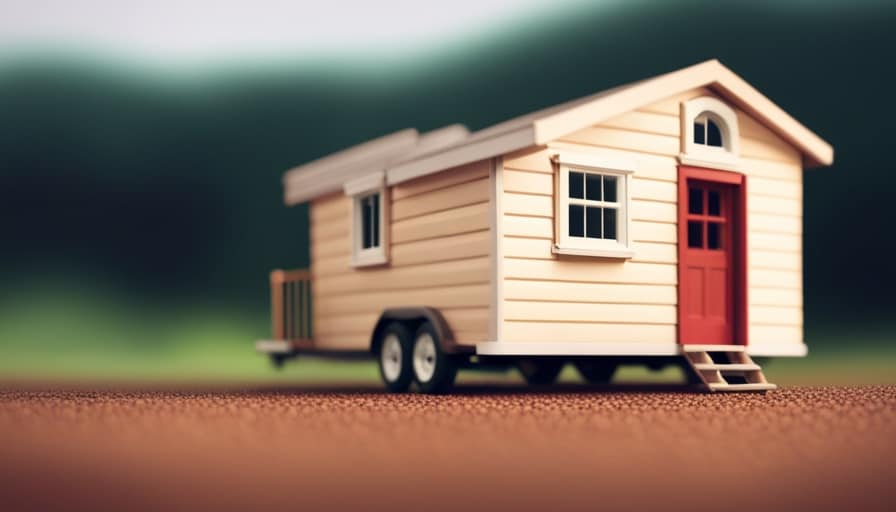
Are There Any Specific Requirements for the Size or Design of a Tiny House in Fresno?
In Fresno, specific requirements exist for the size and design of tiny houses. The city has set guidelines to ensure safety and conformity. Meeting these requirements is crucial to obtaining necessary permits and building a legally compliant tiny house.
Can I Legally Live in a Tiny House on Wheels in Fresno?
Yes, you can legally live in a tiny house on wheels in Fresno. While specific regulations may vary, other cities have implemented tiny house regulations with benefits such as affordability, sustainability, and minimal environmental impact.
How Can I Find Resources and Support for Building My Own Tiny House in Fresno?
Finding local workshops and connecting with tiny house builders in Fresno is crucial for building my own tiny house. Through thorough research and analytical thinking, I can discover resources and support to ensure a successful project.
Are There Any Financial Incentives or Grants Available for Individuals Interested in Building a Tiny House in Fresno?
There are financial assistance programs and grants available for individuals interested in building a tiny house in Fresno. It’s important to familiarize yourself with the building regulations and requirements to ensure compliance.
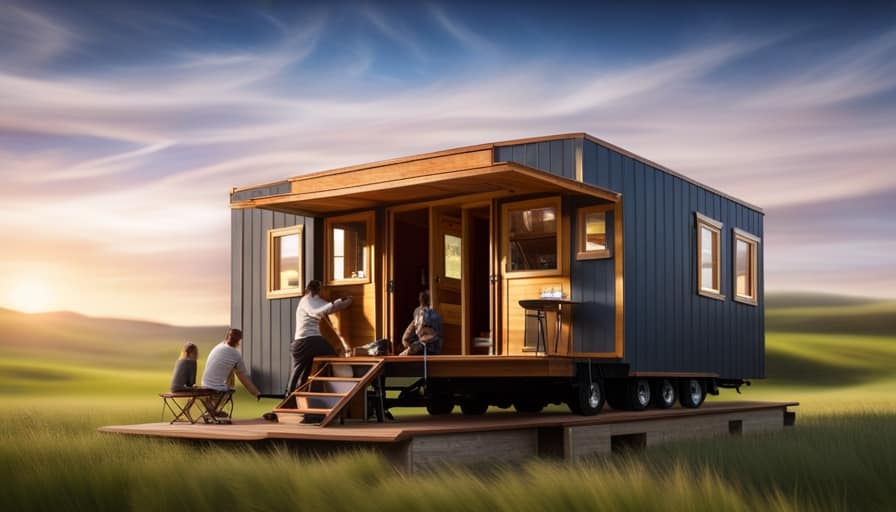
Conclusion
In conclusion, the city of Fresno has successfully embraced the tiny house movement through a shift in housing policies, collaboration with advocates, and innovative communities.
The zoning regulations and permitting processes have been streamlined to accommodate tiny house living. Despite challenges, the city has built a strong foundation for the tiny house movement to thrive.
As the saying goes, "The journey of a thousand miles begins with a single step," and Fresno has taken that step towards a more sustainable and affordable housing solution.
I’m Theodore, and I love tiny houses. In fact, I’m the author of Tiny House 43, a book about tiny houses that are also tree houses. I think they’re magical places where imaginations can run wild and adventures are just waiting to happen.
While tree houses are often associated with childhood, they can be the perfect adult retreat. They offer a cozy space to relax and unwind, surrounded by nature. And since they’re typically built on stilts or raised platforms, they offer stunning views that traditional homes simply can’t match.
If you’re looking for a unique and romantic getaway, a tree house tiny house might just be the perfect option.
Beginners Guides
How Do I Get Rid of Tiny Black Flies in My House
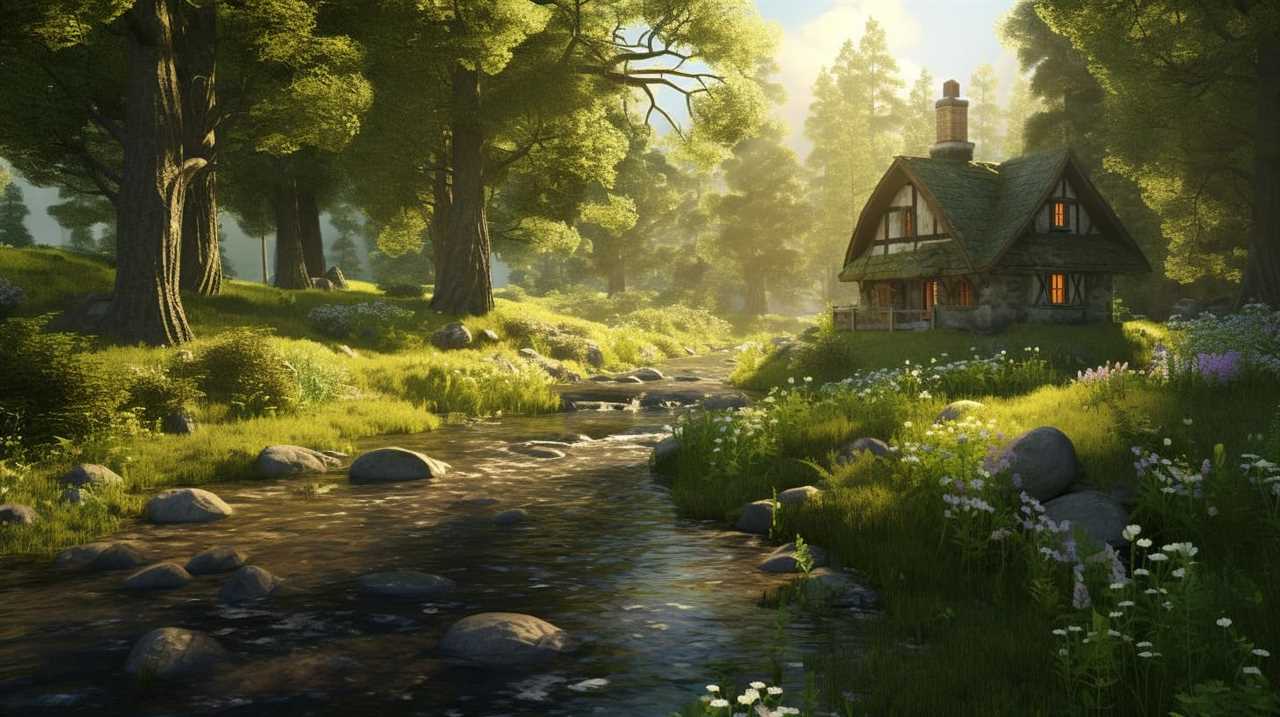
- Health risks associated with tiny black flies in the house
- Effective methods to prevent and control the presence of black flies in homes or gardens
I have tried every possible solution, but those annoying tiny black flies refuse to leave my house!
If you’re dealing with the same frustrating problem, don’t worry – I’ve got you covered.
In this article, I’ll share my expert knowledge on identifying these pesky bugs, understanding the causes of their infestations, and provide you with both natural and chemical remedies to banish them for good.
Say goodbye to those annoying flies and hello to a fly-free home!
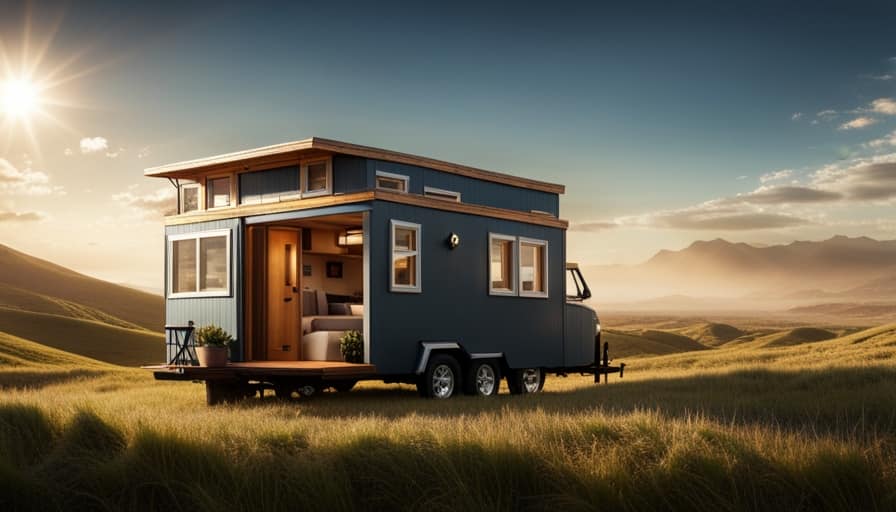
Key Takeaways
- Identify and eliminate breeding grounds by removing standing water and damp areas.
- Use natural remedies like homemade fly traps with apple cider vinegar and essential oils to repel flies.
- Consider using chemical treatments designed to kill black flies, following the instructions carefully.
- Take preventive measures to keep your house clean and free from food or organic debris to prevent future infestations.
Identifying the Tiny Black Flies
I can use a magnifying glass to examine the tiny black flies and determine their species. When it comes to differentiating between fruit flies and black flies, there are a few key characteristics to look out for.
Fruit flies are usually smaller in size, about 1/8 of an inch long, and have a tan or yellowish body with red eyes. On the other hand, black flies are slightly larger, measuring around 1/4 of an inch, and have a dark black or grayish body with dark wings.
Now, let’s move on to controlling and eliminating black flies in outdoor spaces. One effective method is to eliminate their breeding grounds by removing any standing water or damp areas where they can lay their eggs. Regularly emptying and cleaning birdbaths, flower pots, and gutters can help prevent black fly infestations.
Additionally, using insect repellents or installing fine mesh screens on doors and windows can provide some protection against these pesky pests.

Understanding the Causes of Black Fly Infestations
To understand the causes of black fly infestations, we need to examine their preferred breeding sites and environmental conditions. These tiny pests thrive in moist and decaying organic matter, making the following places common breeding grounds for black flies:
-
Standing water: Black flies lay their eggs in standing water, such as ponds, lakes, and even puddles. It’s crucial to eliminate any stagnant water sources around your house to prevent infestations.
-
Overgrown vegetation: Black flies are attracted to dense vegetation, especially if it’s near water bodies. Trim shrubs, mow your lawn regularly, and remove any overgrown plants to discourage black flies from breeding.
-
Moist organic matter: Black flies lay their eggs in decomposing leaves, grass clippings, and other organic debris. Keep your yard clean and free of debris to reduce the likelihood of black fly infestations.

Understanding these common breeding grounds can help you identify and eliminate the causes of black fly infestations, keeping your home fly-free and comfortable.
Natural Remedies to Eliminate Tiny Black Flies
With a combination of proper sanitation and natural remedies, you can effectively eliminate tiny black flies from your house. One effective natural remedy is making homemade fly traps. These traps can be made using common household items such as apple cider vinegar, dish soap, and a plastic bottle. Simply cut the bottle in half, pour a mixture of apple cider vinegar and dish soap into the bottom half, and place the top half of the bottle inverted into the bottom half. The flies will be attracted to the scent of the vinegar, but the dish soap will prevent them from escaping. Another natural remedy is using essential oils for fly control. Oils such as lavender, peppermint, and eucalyptus have strong scents that repel flies. Simply mix a few drops of your chosen oil with water and spray it around areas where flies are present. By incorporating these natural remedies into your fly control routine, you can effectively get rid of tiny black flies in your house.
| Homemade Fly Traps | Essential Oils for Fly Control |
|---|---|
| – Apple cider vinegar and dish soap mixture in a plastic bottle | – Lavender, peppermint, and eucalyptus oils |
| – Flies are attracted to the vinegar scent but trapped by the soap | – Mix a few drops with water and spray in affected areas |
| – Simple and cost-effective solution | – Oils have strong scents that repel flies |
| – Dispose of trapped flies regularly | – Repeat application as needed |
Chemical Treatments for Getting Rid of Black Flies
By using chemical treatments, you can effectively eliminate black flies from your house. Here are three options to consider:
-
Chemical insecticides: These products are specifically designed to kill insects, including black flies. Look for insecticides that are labeled for use against flies and follow the instructions carefully. Apply the insecticide in areas where black flies are commonly found, such as around windows, doors, and other entry points.

-
Fly traps: There are chemical-based fly traps available that attract and capture black flies. These traps use a combination of chemicals and pheromones to lure the flies in and prevent them from escaping. Place the traps in areas where black flies are present, such as near garbage cans or in the kitchen.
-
Professional exterminator: If you’re dealing with a severe infestation or if chemical treatments haven’t been effective, it may be best to call a professional exterminator. They have access to stronger chemicals and can provide a targeted approach to eliminate black flies from your house.
Remember to always read and follow the instructions on chemical insecticides and traps, and consider the help of a professional if needed.
Preventing Future Infestations of Tiny Black Flies
My best advice for preventing future infestations of tiny black flies in my house is to maintain proper sanitation and eliminate potential breeding grounds.

To maintain a fly-free environment, it’s important to keep your house clean and free from any food or organic debris. Make sure to regularly clean your kitchen, especially the countertops, sinks, and garbage disposal areas. Keep all food stored in airtight containers and promptly clean up any spills or crumbs.
Additionally, it’s crucial to identify and eliminate common breeding grounds for black flies in homes. These include standing water, damp areas, and overwatered plants. Regularly check for any leaks or moisture issues and fix them promptly.
Frequently Asked Questions
Can These Tiny Black Flies Harm Humans or Pets?
I’m not an expert, but I can share that tiny black flies in the house might be annoying, but they usually don’t harm humans or pets. It’s always a good idea to take preventive measures to control their presence.
Are There Any Specific Regions or Climates Where These Black Flies Are More Common?
In certain regions and climates, these pesky black flies tend to be more common. Understanding their preferences can help in devising effective strategies to keep them at bay.
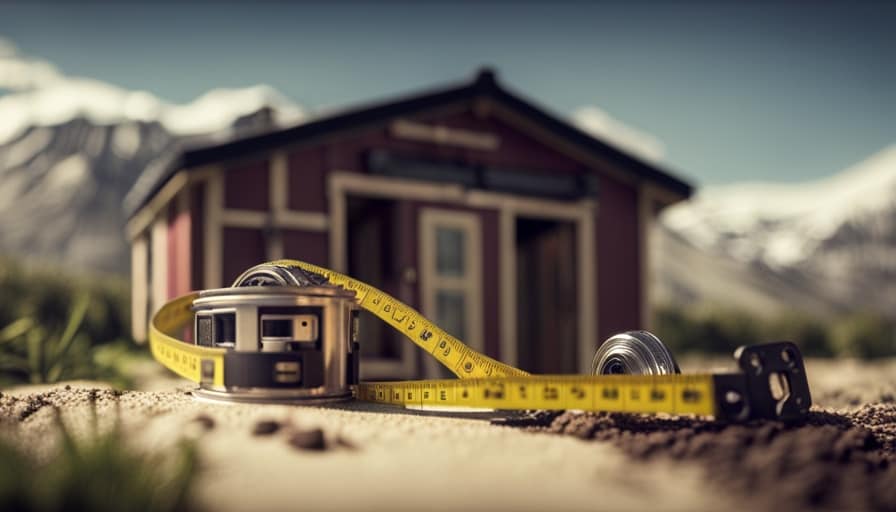
Can These Tiny Black Flies Cause Damage to Plants or Food?
Yes, these tiny black flies can cause damage to indoor plants as they lay their eggs in the soil. They can also contaminate stored food by landing on it and leaving behind bacteria.
How Long Does It Usually Take for Natural Remedies to Effectively Eliminate Black Flies?
On average, natural remedies can effectively eliminate black flies within a few days. However, the exact time may vary depending on the severity of the infestation and the specific remedies used.
Are There Any DIY Traps or Baits That Can Be Used to Catch and Eliminate These Tiny Black Flies?
There are several DIY fly traps and effective baits that can be used to catch and eliminate those pesky tiny black flies. Let me share some knowledge and details on how you can tackle this issue.
Conclusion
So there you have it, a plethora of methods to bid farewell to those pesky tiny black flies that have invaded your humble abode.

From natural remedies to chemical treatments, we’ve covered it all.
Now, armed with this knowledge, you can take control of your home and ensure these unwelcome guests never return.
Happy fly-free living!
I’m Theodore, and I love tiny houses. In fact, I’m the author of Tiny House 43, a book about tiny houses that are also tree houses. I think they’re magical places where imaginations can run wild and adventures are just waiting to happen.
While tree houses are often associated with childhood, they can be the perfect adult retreat. They offer a cozy space to relax and unwind, surrounded by nature. And since they’re typically built on stilts or raised platforms, they offer stunning views that traditional homes simply can’t match.
If you’re looking for a unique and romantic getaway, a tree house tiny house might just be the perfect option.
Beginners Guides
How Do I Get Rid of Tiny Bugs in My House

I have pests in my home that are causing me frustration! They are like small intruders that are appearing all over the place. However, do not worry, as I have conducted thorough research and found effective solutions to eliminate these bothersome pests.
In this article, I’ll guide you through identifying the types of bugs, understanding the causes of infestations, and providing natural and chemical remedies to eliminate them.
Say goodbye to those unwelcome guests and hello to a bug-free home!
Key Takeaways
- Identifying the specific pest by observing droppings or behavior is crucial in getting rid of tiny bugs in the house.
- Proper sanitation practices, such as keeping the kitchen and dining areas clean, are important in preventing bug infestations.
- Natural remedies like herbal insecticides and essential oils can be effective in deterring bugs without the use of harsh chemicals.
- Regular cleaning, sealing cracks, and maintaining a tidy home are essential in preventing future bug infestations.
Identifying the Types of Tiny Bugs in Your House
I can easily identify the types of tiny bugs in my house by observing their physical characteristics and behavior. One of the most common signs of an infestation is the presence of droppings or excrement. Different types of bugs leave different types of droppings, which can help determine the specific pest in your house.

Additionally, observing the behavior of the bugs can provide valuable information. Some bugs are more active during the day, while others are nocturnal. Some bugs may prefer certain areas of the house, such as the kitchen or bathroom.
If you’re unsure about the type of bug in your house, it’s advisable to consult with professional exterminators who’ve the expertise to accurately identify and eliminate the pests.
Understanding the Common Causes of Bug Infestations
One of the most common causes of bug infestations is a lack of proper sanitation practices in the home. Understanding bug behavior and knowing their common household bug habitats can help prevent infestations.
Bugs are attracted to food sources, so it’s important to keep the kitchen and dining areas clean and free of crumbs and spills. Regularly emptying and cleaning garbage cans can also deter bugs from entering the home.

Additionally, bugs thrive in warm and moist environments, so it’s important to fix any leaks or damp areas in the house. Cluttered spaces provide hiding spots for bugs, so keeping the home organized and decluttered can help minimize their presence.
Natural Remedies to Get Rid of Tiny Bugs in Your House
To effectively eliminate tiny bugs in your house, try using natural remedies with ingredients such as vinegar and essential oils. Natural remedies are a great option for those who prefer non-toxic solutions and want to avoid harsh chemicals.
One effective natural remedy is using herbal insecticides. These insecticides are made from plant-based ingredients and can be sprayed in areas where bugs are commonly found, such as corners, cracks, and crevices.
Another natural remedy to consider is essential oils. Certain essential oils, such as peppermint, lavender, and tea tree oil, have insect-repellent properties. Simply mix a few drops of the essential oil with water and spray it around your house to deter bugs.

These natural remedies can be a safe and effective way to get rid of tiny bugs in your house.
Chemical Treatments for Eliminating Tiny Bugs
There are several effective chemical treatments available to eliminate tiny bugs in your house. When it comes to pest control methods, using insecticides is a common and efficient approach. There are various types of insecticides on the market, each with its own advantages and disadvantages.
It’s important to compare different insecticides to determine which one is best suited for your needs. Some insecticides target specific bugs, while others have a broad spectrum of effectiveness. Additionally, consider the application method and the duration of effectiveness. Some insecticides require direct contact with the bugs, while others can be used as a residual treatment.
It’s also essential to follow the safety instructions provided by the manufacturer when using chemical treatments to ensure the well-being of both humans and pets in your home.
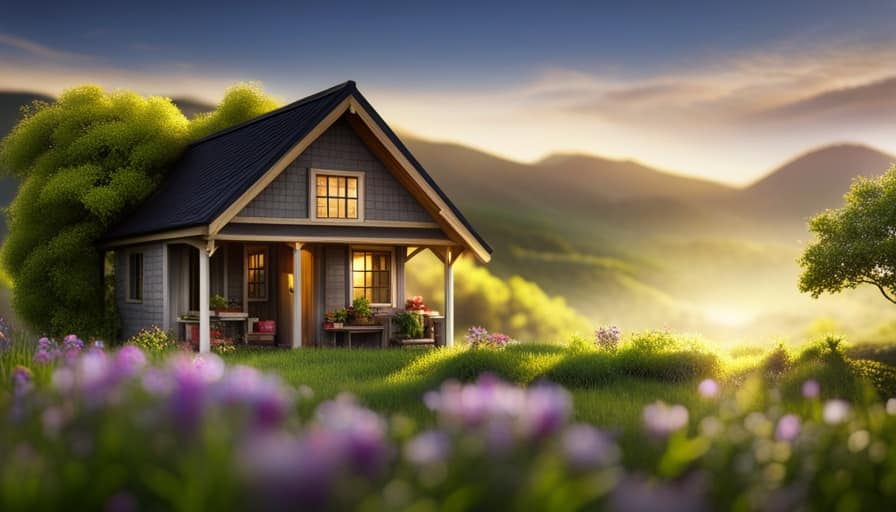
Preventing Future Bug Infestations in Your Home
I’ll make sure to regularly clean and seal any cracks in my house to keep bugs from coming in. Effective cleaning techniques are crucial in preventing bug infestations and creating a bug-free environment. Maintaining a clean and tidy home is essential to minimize the presence of bugs. Regularly vacuuming carpets and upholstery, sweeping and mopping floors, and wiping down surfaces will help eliminate any crumbs or food particles that may attract bugs. Additionally, proper food storage is essential to prevent bugs from being attracted to your kitchen. Keeping food in sealed containers and promptly cleaning up spills or crumbs will deter bugs from entering your home. Regularly inspecting and repairing any cracks or gaps in windows, doors, and walls will also help prevent bugs from finding their way inside.
| Cleaning Techniques | Maintenance Tips |
|---|---|
| Vacuum carpets and upholstery | Inspect and repair cracks or gaps |
| Sweep and mop floors | Properly store food to deter bugs |
| Wipe down surfaces | Regularly clean and seal cracks |
| Dispose of trash regularly | Keep a tidy and clutter-free home |
Frequently Asked Questions
Can These Tiny Bugs Cause Any Harm to Humans or Pets?
I’m not sure about the specific bugs in your house, but some tiny bugs can cause harm to humans or pets. It’s important to address the bug infestation promptly to protect your health and take preventive measures to keep them out.
How Long Does It Typically Take for Natural Remedies to Effectively Get Rid of Tiny Bugs?
It typically takes a few weeks for natural remedies to effectively eliminate tiny bugs. However, it’s important to note that results may vary. As for side effects, natural remedies are generally safe for humans and pets.
What Are Some Signs That Indicate a Bug Infestation in the House?
Signs of a bug infestation in the house include seeing live or dead bugs, finding their droppings or eggs, and noticing damage to furniture or walls. Preventing bug infestations involves keeping a clean and tidy home, sealing entry points, and using insect repellents.
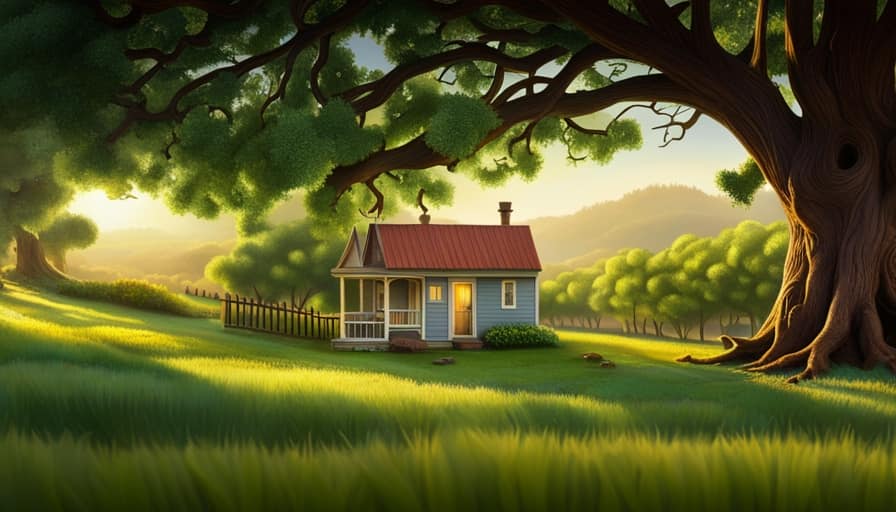
Are There Any Specific Areas in the House Where These Tiny Bugs Are Commonly Found?
In my experience, tiny bugs tend to hide in common areas like kitchen cabinets, bathrooms, and near windows. To prevent them, I recommend regular cleaning, sealing cracks, and keeping food stored properly.
Can Certain Weather Conditions or Changes in the Environment Attract These Tiny Bugs Into the House?
Certain weather conditions or changes in the environment can attract these tiny bugs into the house. Factors like warm and humid weather, open windows, and presence of organic matter can make your home more inviting for them.
Conclusion
In conclusion, while it can be frustrating to deal with tiny bugs in your house, there are effective ways to get rid of them.
By identifying the types of bugs and understanding the common causes of infestations, you can take natural or chemical treatments to eliminate them.

Additionally, taking preventive measures can help to avoid future bug infestations.
Remember, with the right knowledge and strategies, you can create a bug-free environment in your home.
I’m Theodore, and I love tiny houses. In fact, I’m the author of Tiny House 43, a book about tiny houses that are also tree houses. I think they’re magical places where imaginations can run wild and adventures are just waiting to happen.
While tree houses are often associated with childhood, they can be the perfect adult retreat. They offer a cozy space to relax and unwind, surrounded by nature. And since they’re typically built on stilts or raised platforms, they offer stunning views that traditional homes simply can’t match.
If you’re looking for a unique and romantic getaway, a tree house tiny house might just be the perfect option.
-

 Beginners Guides2 weeks ago
Beginners Guides2 weeks agoHow To Buy A Tesla Tiny House
-

 Energy Efficiency2 months ago
Energy Efficiency2 months agoBest Tiny Homes For Cold Climates
-

 Beginners Guides1 week ago
Beginners Guides1 week agoTiny House Nation Where Are They Now Stephanie
-

 Tiny House Resources (e.g., legalities, cost, insurance, FAQs)2 months ago
Tiny House Resources (e.g., legalities, cost, insurance, FAQs)2 months agoDo Tiny Homes Need Planning Permission?
-

 Beginners Guides3 weeks ago
Beginners Guides3 weeks agoFrom The Show Tiny House Nation How Many Keep Their Tiny House?
-

 Beginners Guides2 months ago
Beginners Guides2 months agoUsing a Climbing Net For Treehouse Construction
-

 Beginners Guides2 months ago
Beginners Guides2 months agoHow to Build a Treehouse Without Drilling Into the Tree
-
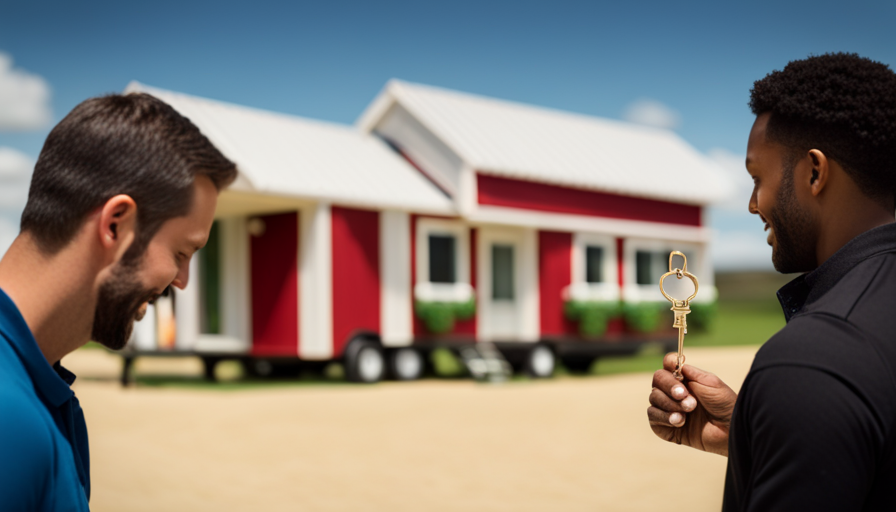
 Beginners Guides3 weeks ago
Beginners Guides3 weeks agoTiny House Nation Who Pays For The Houses




